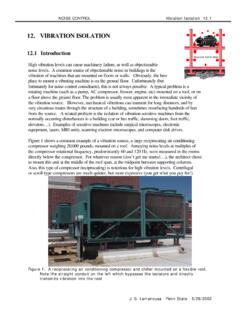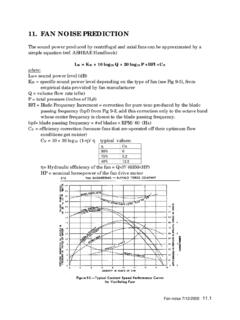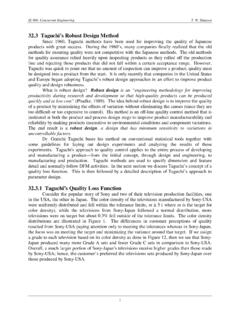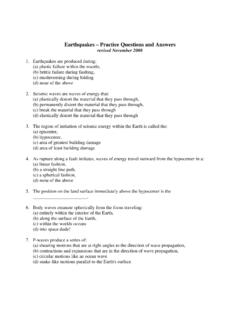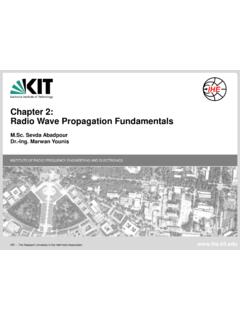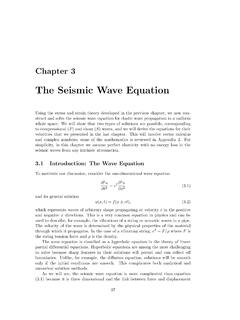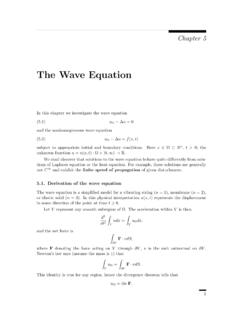Transcription of 5. PHYSICS OF SOUND - Pennsylvania State University
1 NOISE CONTROL PHYSICS of SOUND 5. PHYSICS OF SOUND . Definition: SOUND - a disturbance which propagates through an elastic material at a speed which is characteristic of that material. SOUND is usually caused by radiation from a solid vibrating surface or fluid disturbances. ACOUSTIC VARIABLES. As SOUND propagates through air (or any elastic medium), it causes measurable fluctuations in pressure, velocity, temperature and density. We can describe the physical State in terms of mean (steady State ) values and small fluctuations about that mean. For our purposes in acoustics and noise control, all we care about is the fluctuating portion.
2 Physical Quantity State Variable Units Pressure: Ptotal = P + p(r,t) (Pascals). Velocity: Utotal = U + u(r,t) (meters/second). Temperature: Ttotal = T + (r,t) ( Celsius). Density: total = + (r,t) (kg/m3). Pressure (psi). Patm = Time (seconds). Figure 1. Variation of SOUND pressure about the mean value (1 atm). P = 1 standard atmosphere = psi = bars = x 105 Pa Useful Conversion Factors: 1Pa = 1 N/m2 = 10 Bar 1 Psi = 6894 Pa Typical SOUND pressure magnitudes range from just barely audible, 20 Pa or 3 x 10-9 psi (0 dB, the threshold of hearing) to the threshold of pain at approximately 60 Pa or .009 psi (130 dB).
3 A. typical conversation level is Pa (74 dB). It is easiest to measure SOUND pressure in air with a microphone. It is possible, but more difficult to measure acoustic velocity. That's why we mostly talk about SOUND pressure, because it's easiest to measure. J. S. Lamancusa Penn State 12/5/2000. NOISE CONTROL PHYSICS of SOUND The ratio of pressure to particle velocity is a useful quantity and is called Impedance: The specific acoustic impedance is the complex ratio (since both p and u are complex quantities) of the effective SOUND pressure at a point of an acoustic medium or mechanical device, to the effective particle velocity at that point.
4 The unit is the mks rayl (Newton/cubic meter). p Z=. u SOUND waves . The SOUND disturbance travels in space. There is energy transport (the disturbance propagates), but there is no net transfer of mass (no convection). Each particle in the fluid moves back and forth about one position. In general, SOUND waves in any medium can be a mixture of longitudinal and shear waves , depending primarily on the boundary conditions. See ~drussell/Demos/ for animations of longitudinal and shear waves . Longitudinal Wave Simplest type of wave is compressional (or longitudinal wave) where the particle oscillation is in the same direction as the energy transport.
5 The disturbance propagates in the direction of the particle motion. This is the predominant mechanism in fluids and gases because shear stresses are negligible. Particle motion Energy Shear Wave The particle motion direction is orthogonal (perpendicular) to direction in which the disturbance (and the energy) propagates. In solids, you can have transverse shear and torsional waves . Bending waves (in a beam or plate), and water waves are a mixture of shear and longitudinal waves . Particle motion Energy SPEED OF SOUND . For a longitudinal wave in an unbounded medium, SOUND travels at a speed of c: E E = Young's modulus for a solid material, or the bulk modulus for a fluid c=.
6 = density of the material V. Bulk Modulus = V = Volume V / P. J. S. Lamancusa Penn State 12/5/2000. NOISE CONTROL PHYSICS of SOUND In normal gases, at audible frequencies, the pressure fluctuations occur under essentially adiabatic conditions (no heat is transferred between adjacent gas particles). Speed of SOUND then becomes: P Cp c= where : = = for air and P = RT (Ideal Gas Law). Cv For gases, the speed of SOUND is solely a function of temperature and, to a smaller extent humidity since that changes the gas mixture and its density.*. c = RT = T ( o K ) (meters/second) K = C + o = T ( R ) (feet/second) R = F + example: @ 20 C c = 343 m / sec or 1126 ft / sec *Except when the acoustic pressure exceeds ~ 10 Pa, in which case the SOUND velocity varies with pressure.
7 This is the realm of non-linear acoustics, which is beyond the scope of this course. This typically happens in sonic booms. (How many dB is 10 Pa?). Depending on what the propagation medium is, the SOUND speed can change with frequency. Non-Dispersive Medium SOUND speed is independent of frequency, therefore the speed of energy transport and SOUND propagation are the same. Air is a non-dispersive medium. Dispersive Medium SOUND speed is a function of frequency. The spatial and temporal distribution of a propagating disturbance will continually change. Each frequency component propagates at each its own phase speed, while the energy of the disturbance propagates at the group velocity: Cg.
8 Water is an example of a dispersive medium. WAVE EQUATION. Acoustic phenomena are generally associated with small fluctuations (linear acoustics), which 2 1 2 p are described mathematically by the linearized wave equation: p = 2 2 . c t PLANE WAVE propagation . For plane wave propagation (pressure varies in only one dimension, x), the linearized wave equation reduces to: 2 p 1 2 p =. x 2 c 2 t 2. J. S. Lamancusa Penn State 12/5/2000. NOISE CONTROL PHYSICS of SOUND An example of a plane wave would be a speaker at the end of a long tube. If you poke around with a microphone you will find that the SOUND pressure is constant everywhere in the tube.
9 If scan along a cross section of the pipe you will observe that all the particles along that cross section are moving in phase. In other words, the radiating wavefront is a plane. Other examples of plane wave propagation are if you have a large flat surface which is uniformly vibrating. In the immediate proximity of the surface, the SOUND pressure is constant. See for an animation of plane waves . The general plane wave solution for pressure p is made up of waves traveling in both the positive and negative directions: x x p ( x, t ) = f1 (t ) + f 2 (t + ). c c This physically corresponds to a pressure wave traveling in +x direction and a pressure wave traveling in x direction.
10 1. The acoustic particle velocity is related to pressure by: u ( x, t ) = p ( x, t ). c p ( x, t ). The impedance is: Z= = c u ( x, t ). ( c sometimes called the characteristic impedance of the medium). Since any function can be represented by Fourier analysis as a sum of harmonic pieces, a basic solution building block is a sinusoidal wave which propagates in the +x direction: p( x, t ) = A sin[kx t + ]. where: = frequency (radians/sec) =phase angle (radians) k = /c = wavenumber This is a wave, whose amplitude, A does not vary. The wave repeats each time the argument in the square brackets changes by 2 n radians.
